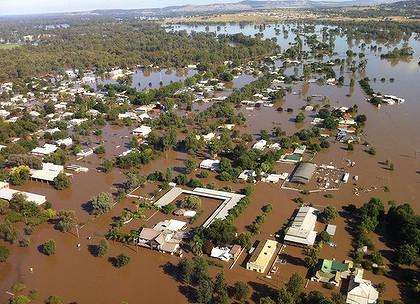The Murray-Darling floods may seem like an anomaly, but they fit within the IPCC pattern for climate change in Australia. [13 March 2012 | Peter Boyer]
The long-suffering people of the Murray-Darling basin don’t need to be told that Australia’s biggest river system is now awash with water.
Two years ago the system looked broken, barely alive after more than a decade of devastating drought culminating in a hot, smoky 2009 summer. The joy of drought-breaking rain that year turned to pain as floodwaters inundated homes and farmlands.
Much of the southern part of the Murray-Darling system escaped serious flooding — that is, until last week’s deluge over seven consecutive days covering a vast area from south-eastern Northern Territory to Victoria’s Gippsland. People said they’d never seen anything like it.
They were probably right. Daily totals for 18 stations across the region, most with records dating back over a century, were their highest ever. Over a week, Ivanhoe in southern NSW came within a whisker of its yearly average and Victoria’s Mt Buffalo copped a whopping 525 mm.
What’s new? Since time beyond memory, the story of Australia has been one of prolonged drought broken by intense rain, bringing the floods that over millions of years created the Murray-Darling’s alluvial plains.
Modelling of southern Australia’s climate for the 2007 report of the Intergovernmental Panel on Climate Change (IPCC) pointed to a pattern through the 21st century of decreasing winter and spring rainfall and a greater risk of drought.
Taking that as a cue, I and many others wondered whether the Murray would ever again flow down to the sea. Such concerns were underlined by the 2009 heatwave, reinforcing the rule that more greenhouse gases increase the prospect of more, and more extreme, hot weather.
We needed to be more circumspect. Climate is determined over decades or centuries. While more extreme heat is virtually a given, rainfall (or the lack of it) adds a layer of complexity. A single drought event doesn’t add up to climate change any more than a single rain event.
A message underlying all climate research is that whatever the long-term outcome of rising levels of atmospheric carbon, there will be no universal, steady progression towards warmer, drier or wetter conditions. There are no straight lines in climate graphs.
The IPCC did identify an important uncertainty in its projections — the behaviour of El Niño-Southern Oscillation (ENSO), the Pacific Ocean climate cycle whose wetter (La Niña) phase was the driver of last week’s big wet.
The IPCC report also said that with a warming world would come an increased chance of intense, heavy rainfall events. The record rains of last week, like the 2010 Queensland floods, fitted well into that mould.
If droughts and floods are tricky to find a fit in the climate change story, storm events like the colossal Cyclone Yasi that hit north Queensland last year and last week’s tornado outbreak in the United States are an even tougher proposition.
Tornadoes are causing a lot of anxiety in the US. As many as 100 storms over two days early in March killed over 50 people. That followed last year’s disasters — over 1700 twisters killing 550 people, adding up to the fourth deadliest tornado year on record.
So tornadoes would seem to be on the rise, but you’d be a mug to assume that next year will be worse again. Like cyclones (or hurricanes, as they’re called in the US), science has yet to identify reliable multi-year tornado patterns, with active seasons often followed by several quiet ones.
What we can be sure of is that because of a lag in the system, whatever we do to cut emissions now we’ll continue to get warmer still for many years to come. In sync with the global trend, Australia has just had its sixth decade of warming in a row, with 2001 to 2010 the warmest on record.
Over multiple years, that warming points to more extreme events (heat, drought, storms, rain or snow) which taken together will mean a higher chance of damage to people and infrastructure.
With the latest flood disaster, the Australian insurance industry is bracing itself for another hit. It will do all it can to minimise any additions to an already huge payout on flood events a year ago.
It’s not alone. As the top-end reinsurance industry knows only too well, damage claims are rising throughout the developed world where insurance is routinely taken out on property, notably in Japan, Europe (including the UK) and North America.
The biggest insurance claims in Japan and New Zealand are the result of seismic events rather than climate, but they all add to the woes of an already severely stressed industry, which is getting jittery about taking on flood insurance in many countries, including Australia.
Governments are adding to that pressure. The Federal Treasury has drafted a “Reforming Flood Insurance” plan (public comment closed last weekend), in which it proposes to require insurers to offer flood cover in all home and contents policies.
That’ll be popular with the punters now, but it will be another upward pressure on premiums — yet another cost burden in this post-prosperity age.
• The economic consequences of peak oil will be discussed by visiting Canadian authority Nicole Foss at 7pm tonight at the Stanley Burbury Theatre, Sandy Bay and on Thursday at the UTas Newnham Campus, Launceston. Email to reserve a seat, or call 6226 2521.

